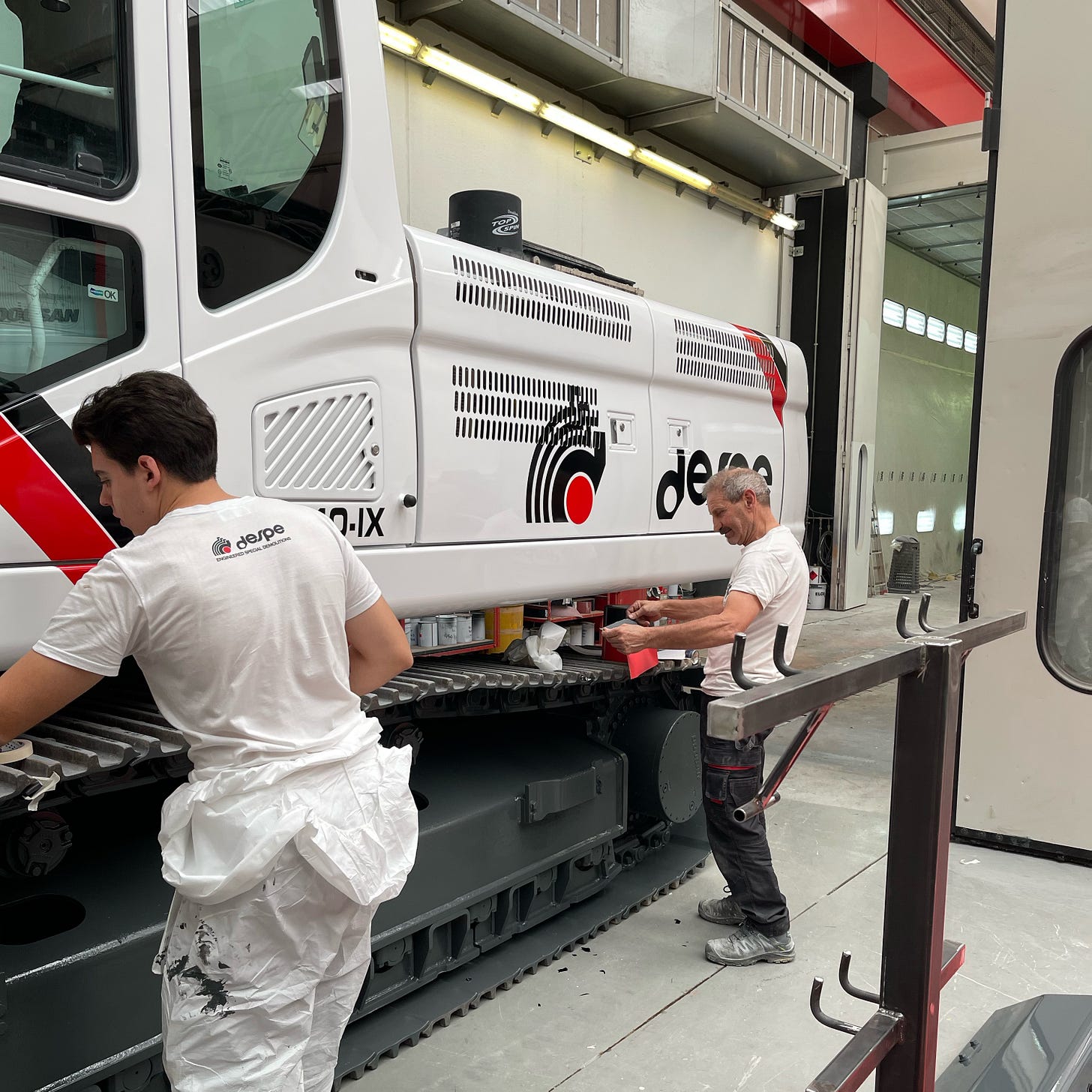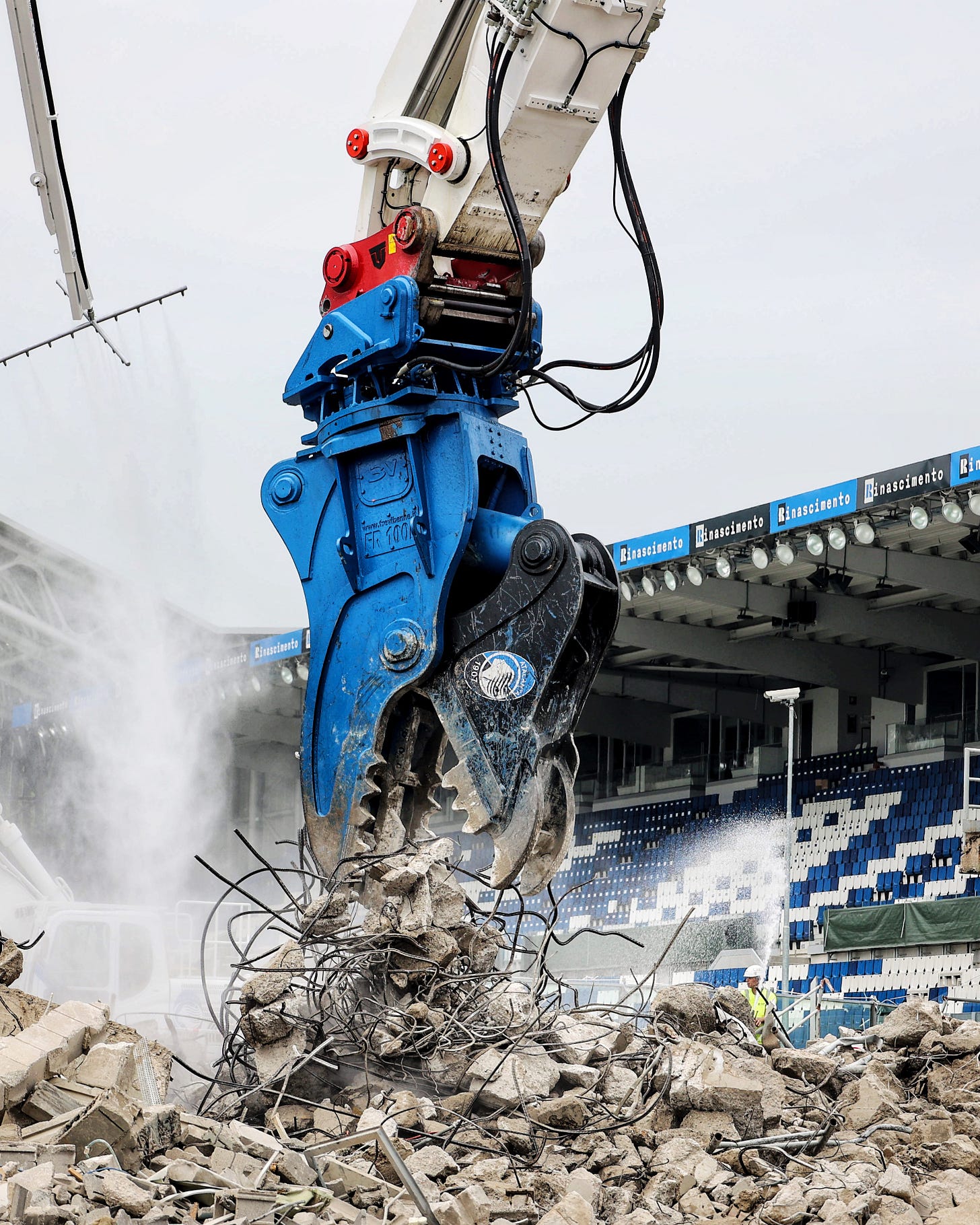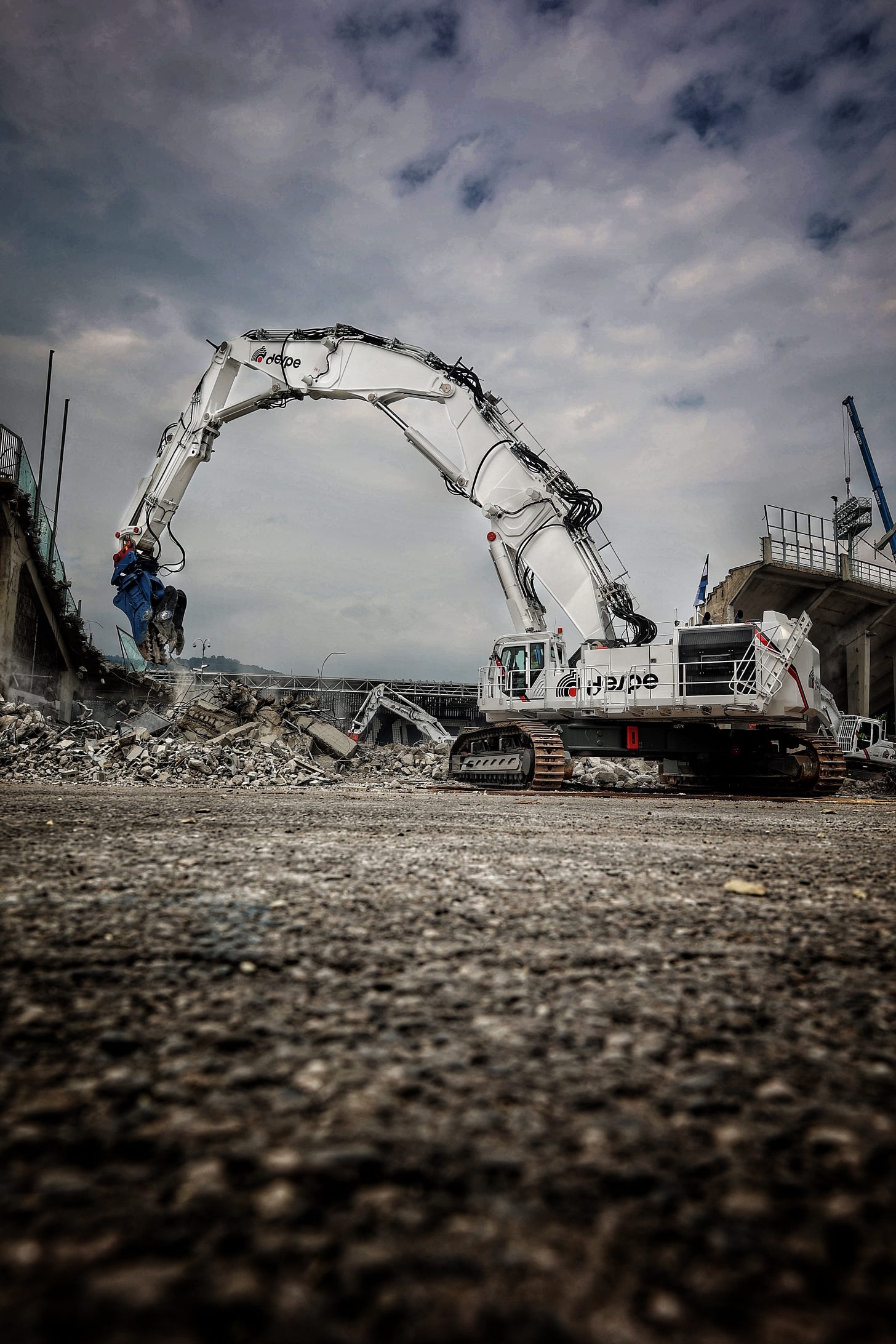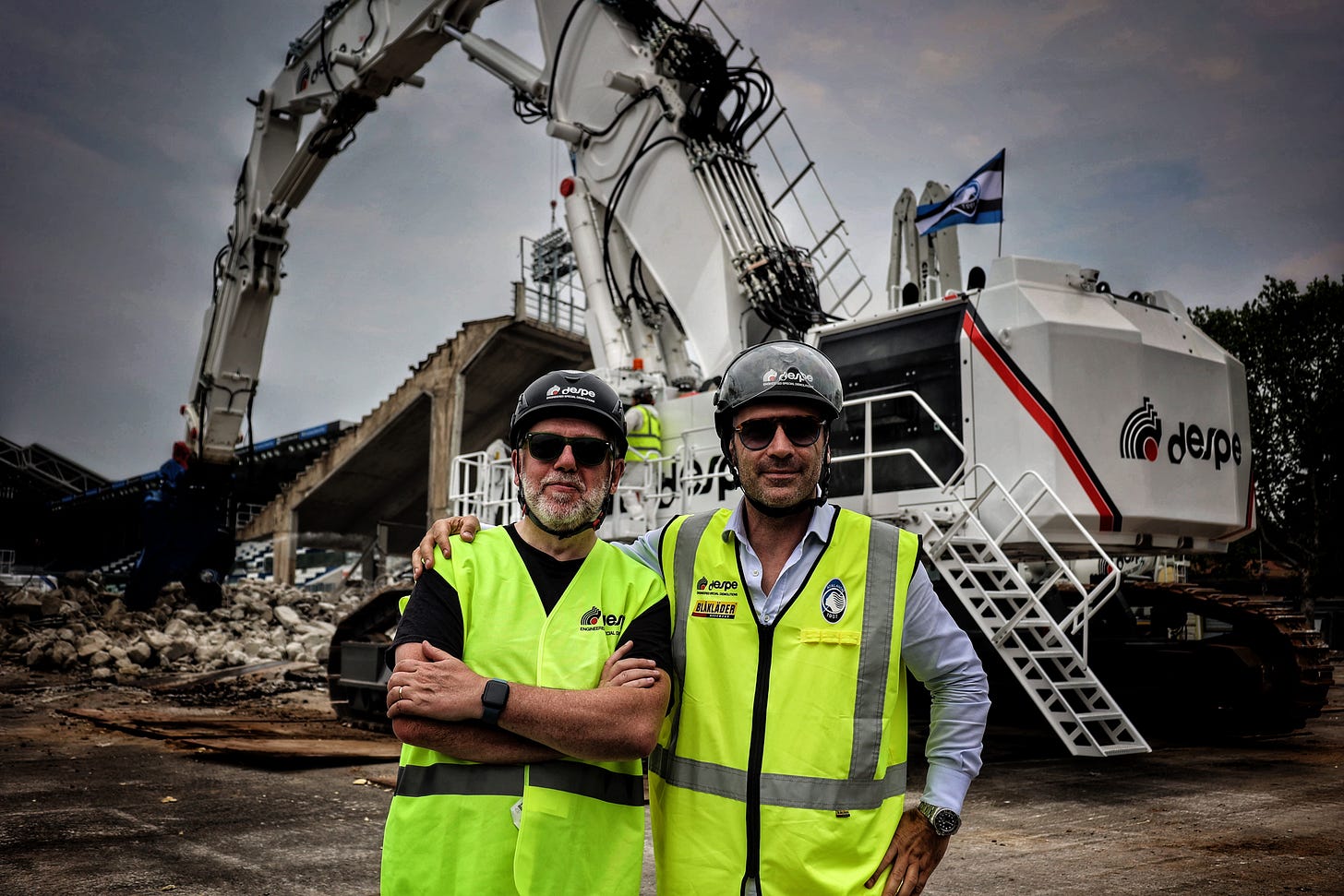JUMBO FANTASTICO
A one-of-a-kind demolition contractor has taken delivery of a one-of-a-kind demolition excavator. DemolitionNews reports.
The email said: “We’d like you to come to Italy. We have something exciting to show you.” That message came from Stefano Panseri, incumbent president of the European Demolition Association and a director (along with his father Giuseppe and brother Roberto) of multiple World Demolition Award winner, Despe.
I have known Stefano for many years and I admire and respect him enormously. I like him even more. I also have huge admiration for Despe, its innovation, and its willingness to tackle demolition works that are beyond the capabilities of many of their peers.
He had me at “we’d like you to come to Italy”.
I still recall seeing Johan Cruyff bamboozling defenders and inspiring children around the world the first time he performed what we now know as the “Cruyff turn”. I remember the Roberto Carlos free-kick against France that seemingly defied the laws of physics. And the first time I saw Cristiano Ronaldo rise three feet above a pair of defenders, appear to hover, before scoring with a header of unprecedented power and precision.
Those moments are iconic because we had never seen their like before. They took the sport in an entirely new direction and redefined what was possible on a football pitch. They were, quite literally, game-changers.
Well, I have just seen another game-changer at the Gewiss Stadium, home of Atalanta Football Club and their devoted blue and black-striped fans.
The moment occurred not on the pitch but right beside it. But it will live as long in my memory as the Cruyff turn and THAT free-kick. It is a memory of something that combines the balance of Zinedine Zidane, the nimble dexterity of prime Lionel Messi, the power of Roberto Carlos’ left foot, and the sheer unstoppable force of Erling Haaland in full flight.
That moment has a name. It is called Jumbo, for reasons that will become soon become apparent.
But that is only part of the story.
Not all demolition contractors are created equal
The Despe headquarters is the stuff of industry myth. Over the years, multiple people have attempted to describe it to me. Those descriptions always sounded apocryphal; legends that were rooted in fact but that had been greatly exaggerated in the constant re-telling. A visit to Despe has been on my bucket list for more than 20 years.
The car pulls up outside the Despe headquarters and it immediately becomes clear that, if anything, previous descriptions had actually understated the reality.
There are no statues, no gaudy fountains. Instead, there are crystal clear pools of water that lend the facility a tranquillity that is at odds with the rough, tough business conducted within. The Despe facility gives off an air of effortless cool. Tony Stark could be working on Iron Man upgrades behind these walls.
The first Despe representative I meet is Ivan Poroli He is achingly well-dressed: a summer weight blazer paired with an elegant and understated tie. On an Englishman, his trousers would be considered dangerously close to “too short” territory. On an Italian, they are perfect. His beard looks as if it may have been trimmed by laser. I suddenly feel hideously under-dressed and stylistically outgunned.
Ivan offers me coffee. I accept, opting for an espresso (when in Bergamo….!). He apologises that it is “from a machine” and then hands me a coffee that is memorably delicious.
We drink our coffee in a huge, well-lit atrium that sums up almost everything you need to know about Despe. In one area, there is a model of an innovative new construction system the company has perfected and which is currently being deployed in Manhattan in the US. At the far end of the space is a huge pile of commemorative books, each arranged according to language. I am proud to say I now have one in my possession. And there, against the back wall, is a row of children’s wheel loaders and excavators. At first, they appear out of place in such a business-like environment. But Despe is first and foremost a family-owned business. And no-one does family quite like the Italians. The children’s toys make perfect sense.
As we are finishing our coffee, we are joined by Cristian Bonomelli (a relatively new recruit to the Despe family) and by Fulvio Gotti. Gotti is the head of Despe’s research and development department (yes, a demolition contractor with a dedicated R&D department). He helped devise a system to hydraulically lower power station boilers to the ground safely. He helped devise another system that allows hydraulic attachments to be suspended from a tower or mobile crane during the demolition of cooling towers and chimney. The orientation of the attachment is controlled by a pair of fans that echo the navigation system on an airship. He is also working on a derivative of the company’s revolutionary Top Down Way that, rather than providing a downward demolition method , offers a ground up construction method.
Lastly, we are joined by Roberto Panseri – son of Giuseppe and brother of Stefano. He bounds in with an enthusiasm that will last the whole day (and, quite possibly, beyond). Roberto apparently believes he is lucky to have me in his office. The truth is, I am honoured to be here.
Where the magic happens
If the administrative part of the Despe headquarters is a picture of quite calm, the workshops are a hive of activity. Over the years, those workshops have gained an almost mythical status in demolition circles. There is talk of them being painted white from floor to ceiling.
That is only partly true. The floor is actually grey in colour. But there is no trace that heavy equipment has ever turned a track upon it. The whole workshop is cleaner than many demolition offices.
That cleanliness begins in a dedicated power washing station that removes dust, dirt and debris from machines and attachments as they arrive. (In typical fashion, that water is circulated and filtered to eliminate any potential environmental impact).
Returning machines and attachments are then repaired and repainted - yes, repainted - in a dedicated spray booth. Despe stickers and other markings are painstakingly reapplied by hand. I followed a five year-old Doosan excavator down the line. It looked factory-fresh even though it had racked up thousands of hours of tough demolition work.
I walk past an array of freshly painted high reach booms that seem to stretch on forever, before turning right to see what must be the largest collection of attachments outside of the TreviBenne or Mantovanibenne stock yard.
Each attachment has also been painted according to the Despe colour coding scheme (they really do think of everything). Never mind the United Colours of Benetton. This is the United Colours of Despe.
We take a quick walk through the outside area of the facility which, refreshingly, is NOT a dumping ground for old equipment, before returning to the reception area where a bag awaits me.
Contained within are my site boots (a perfect fit) and a Despe hard hat. That hard hat looks like a cross between a cycle helmet and protective horse-riding headwear. It is lightweight, immediately comfortable and desirably cool.
Chances are, it probably does not meet UK standards that insist that we each wear an upturned bucket on our heads. I brought mine home anyway. It looks awesome on my bookcase.
It is time to go to work.
Baked to perfection
According to Despe director Stefano Panseri, the “Jumbo was created by three pairs of hands” – those of Caterpillar, Despe and Laurini. That description is accurate, unquestionably. But having seen the Jumbo up close, I have a more apt and rather more Italian analogy.
The Jumbo is like the finest Italian pizza. Caterpillar provided the expertly crafted base; Despe selected only the finest toppings; and Laurini baked it all to perfection.
The mighty Jumbo
The first thing that strikes you about Despe’s new Jumbo machine is not its size but its colour. It is purest Despe white from nose to tail. It is a brilliant white, the colour of glaciers. If for some inexplicable reason Apple and Audi forged an alliance to build a demolition excavator, this is what it would look like. It is as sleek and as elegant as anything that has ever sashayed down a runway in the nearby fashion capital of the world, Milan.
The second most striking feature of the new Jumbo machine is that it looks “normal”. Many modified demolition excavators, particularly those in the Ultra High Reach class, have something of the Frankenstein’s monster about them. They look like they have been assembled from spare parts that do not necessarily belong together. They are over-large and out of proportion.
The greatest compliment I can pay the team at Laurini that modified the Jumbo is that there is no sign of them having done so.
Yes, the machine is carrying some additional “junk in its trunk” to counterbalance the 12 tonne tool. The undercarriage it stands upon has been lengthened and widened to provide a more stable base. And the machine looks somehow muscular. When it raises the TreviBenne FR 100N tool off the ground, you fully expect to see a defined bicep flex at the base of the boom.
But in every other way, the machine could easily have rolled off the production line in Batam, Indonesia where the standard Cat 6015B is built.
In fact, it is only when you see the Jumbo alongside a 50-tonne class excavator that its sheer scale becomes apparent. This is a 351-tonne machine. It is more than twice the weight of the Caterpillar machine upon which it is based; and it is operating in a city centre. Yet rather than looking like an over-large fish out of water, the Jumbo looks perfectly at home.
It quickly becomes apparent that the Gewiss Stadium’s Curva Sud Morosini stand is no match for the Jumbo or for the fearsome FR 100N tool it is wielding. That stand may have withstood decades of bouncing Atalanta fans but it crumbles like a leaky footballing defence against the Jumbo’s might. In fact, the machine proves so formidable that the destruction we expected to last for three hours or more is over in less than half that time. I have rarely seen such a display of raw power from a demolition machine. The Jumbo could eat power stations for breakfast, followed by a refinery or offshore oil rig for lunch.
And that is precisely the point. The Jumbo is the living embodiment of demolition productivity. It has been developed and built not out of vanity but out of need. The machine is not there to satisfy the egos of the Despe team. Rather, it has been produced to give the company a significant competitive advantage in the years and even decades to come.
That longevity is a key to the Jumbo’s viability and success. The machine is not cheap; far from it. But with the back-up of Caterpillar, Laurini and Despe’s own in-house maintenance department, the latest Jumbo could easily last as long as the company’s Liebherr 984-based original. If the new Jumbo is still in the company’s fleet 10, 15 or 20 years from now, it will have earned its keep many times over.
The Despe difference
There are two more items of note during my visit to the Gewiss Stadium in Bergamo. Both say much about Despe: its innovation and its attitude.
While I am watching the Jumbo turn a football stand back into its constituent concrete and steel parts, I notice a man standing a short distance away. At first glance, he appears to be a bystander in full PPE. On closer inspection, I can see that he is wearing a remote control console around his neck. And from it, he is controlling a boom that rises out of one of two pure white Despe cement mixers. But the mixers do not contain cement; they are filled instead with water. That water is being deployed carefully, precisely and sparingly onto the attachment and the concrete disintegrating within its jaws.
Roberto Panseri explains that traditional dust suppression systems can create a mist that obscures the view to the attachment for the operator. So, in typical Despe fashion, the company devised a solution that is as accurate as it is effective. The result is to traditional dust suppression systems what the iPhone is to the telegraph. If it doesn’t yet have a patent, it should.
The second item of note is not a machine or a system. But it speaks to the reputation that Despe has forged over the years.
With the Jumbo fast running out of stadium to eat, I ask if it might be possible to go inside the stadium to photograph and film the machine from a different angle.
Roberto Panseri fires off a text message to a director of the Atalanta football club, seeking permission.
It seems unlikely we will be allowed inside as the pitch is currently being reseeded in preparation for the start of the next football season. But Panseri’s phone pings almost instantly, and the message reads: “Yes, of course. But only because you are Despe”.
We shoot some final footage from within the stadium, right there on the hallowed turf, and I am left to ponder that message from the Atalanta director.
Do Stark Enterprises’ style headquarters, pristine white machines, spotlessly clean workshops, cycle-helmet-style hard hats and remotely controlled cement mixer dust suppression systems really work in the field of demolition?
Yes. But only because they are Despe.












